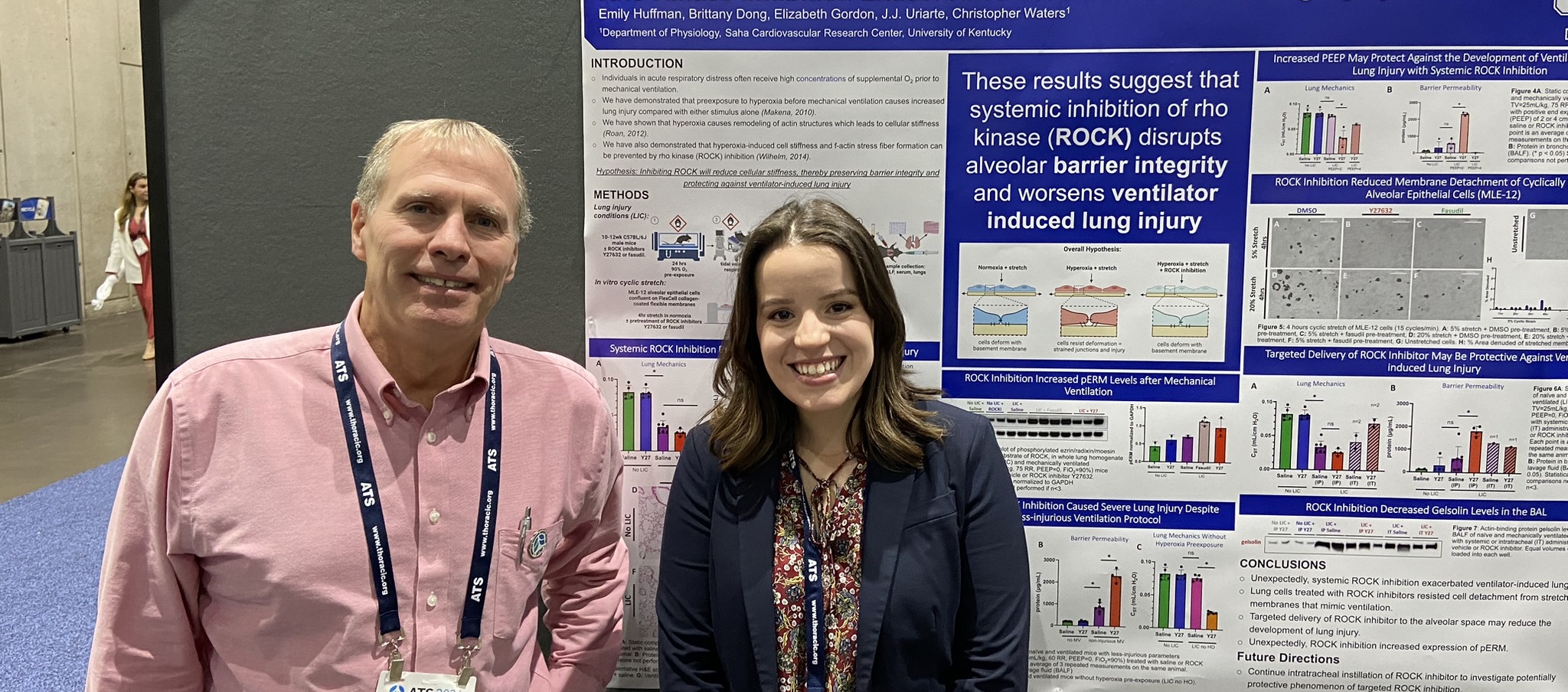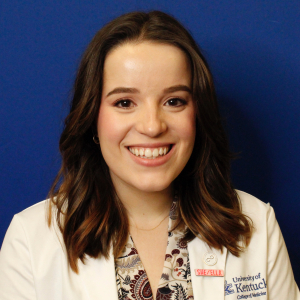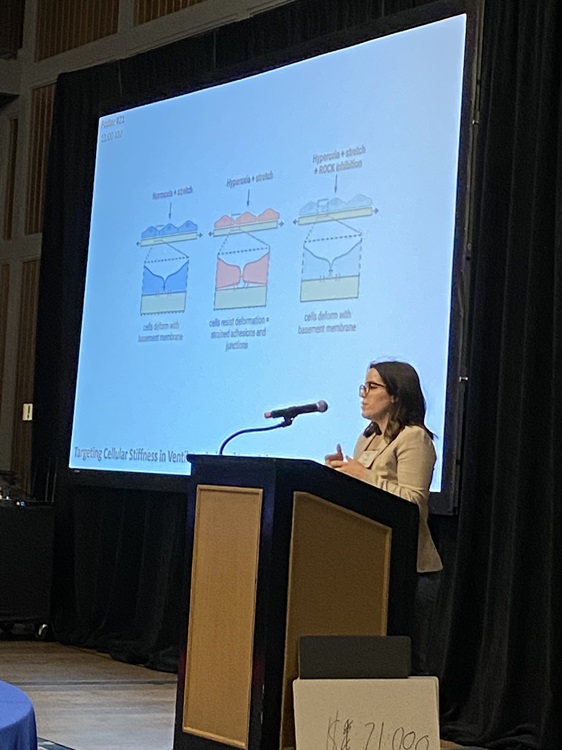

706-721-7859
chrwaters@augusta.edu
Office: CA-2096| Lab: CA - 2095
706-721-7299
Lab Personnel

Emily Huffman
Education & TrainingAcademic AppointmentResearch InterestsAwards & AccomplishmentsPublications
|
University of Tennessee at Chattanooga |
B.S.E. |
08/1985 |
Chemical Engineering |
|
University of Miami (FL) |
M.S. |
06/1987 |
Biomedical Engineering |
|
Vanderbilt University |
Ph.D. |
08/1991 |
Biomedical Engineering |
|
Vanderbilt University |
Postdoctoral |
06/1992 |
Biomedical Engineering |
Professor, Department of Physiology, Medical College of Georgia, Augusta University
Research Physiologist/Principal Investigator, Augusta Veterans Administration Healthcare System, Augusta, GA.
Dr. Donald T. Frazier Professor, Department of Physiology, College of Medicine, University of Kentucky, Lexington, KY.
Professor of Physiology, Saha Cardiovascular Research Center, College of Medicine, University of Kentucky, Lexington, KY.
Director, Kentucky Research Alliance for Lung Disease (K-RALD), University of Kentucky, Lexington, KY.
Research Physiologist/Principal Investigator, Lexington Veterans Administration Healthcare System, Lexington, KY.
Interim Chair, Department of Physiology, College of Medicine, The University of Tennessee Health Science Center, Memphis, TN.
Professor of Physiology, College of Medicine, The University of Tennessee Health Science Center, Memphis, TN
Vice Chair of Physiology, College of Medicine, The University of Tennessee Health Science Center, Memphis, TN
Interim Chair, Department of Physiology, College of Medicine, The University of Tennessee Health Science Center, Memphis, TN.
Professor of Medicine, Division of Pulmonary, Critical Care and Sleep Medicine, College of Medicine, The University of Tennessee Health Science Center, Memphis, TN.
Professor of Orthopaedic Surgery and Biomedical Engineering, The University of Tennessee Health Science Center, Memphis, TN.
Assistant Professor of Biomedical Engineering and Imaging, The University of Tennessee Health Science Center, Memphis, TN.
Adjunct Faculty, Department of Biomedical Engineering, The University of Memphis, Memphis, TN.
Associate Professor of Medicine, Division of Pulmonary, Critical Care and Sleep Medicine, College of Medicine, The University of Tennessee Health Science Center, Memphis, TN.
Associate Professor of Physiology (with tenure), College of Medicine, The University of Tennessee Health Science Center, Memphis, TN.
Assistant Professor of Biomedical Engineering (Joint Appointment, 1996), Department of Biomedical Engineering, Northwestern University, Evanston, IL.
Assistant Professor of Anesthesiology, Department of Anesthesiology, Northwestern University School of Medicine, Chicago, IL.
Assistant Professor of Medicine, Department of Medicine, Northwestern University School of Medicine, Chicago, IL.
Member, Feinberg Cardiovascular Research Institute, Northwestern University School of Medicine, Chicago, IL.
The Waters lab focuses on diseases of the lung with a focus on acute lung injury and pulmonary fibrosis and the role of mechanobiology. Patients with acute respiratory distress syndrome (ARDS) are placed on mechanical ventilators to improve oxygenation, but the ventilator may cause additional injury to the lungs due to either overdistention or airway collapse and reopening. Clinical trials have demonstrated a substantial reduction in mortality in ARDS patients when ventilation strategies are used that reduce overdistention (lower tidal volumes) and minimize airway collapse and reopening (positive end expiratory pressure). The lung is a mechanically dynamic organ, and cells in the lung are subjected to shear stress due to fluid flow, tensile and compressive forces due to respiratory motion, and normal forces due to vascular or airway pressure. High tidal volume mechanical ventilation in injured lungs induces mechanical stresses that increase injury to the lung epithelium, stimulate inflammatory responses, and decrease repair mechanisms. In addition, pulmonary fibrosis results in changes in mechanical properties of the lungs that profoundly impacts gas exchange. We are focusing on the mechanisms by which mechanical forces contribute to lung injury, inhibit wound healing of lung epithelial cells, and stimulate inflammation. We are examining signaling pathways related to injury and repair, pulmonary fibrosis, cell migration and wound healing, inflammasome activation, cytoskeletal remodeling, stimulation of reactive oxygen species, cytokine secretion, and regional variations in cellular tension. In addition we are examining lung injury in vivo and the effects of exposure to high levels of oxygen (hyperoxia). My research seeks to elucidate the molecular mechanisms of lung injury, repair, and remodeling, and to develop approaches to reduce lung disease.

Immanuel, C.N., B. Teng, B.E. Dong, E.M. Gordon, C. Luellen, B. Lopez, J. Harding, S.A. Cormier, E.A. Fitzpatrick, A. Schwingshackl, and C.M. Waters. Two pore potassium channel Trek-1 (K2P2.1) regulates NLRP3 inflammasome activity in macrophages, Am. J. Physiol. Lung Cell. Mol. Physiol . 326: L367-L376, 2024.
Conroy, L.R., H.A. Clarke, D.B. Allison, S.S. Valenca, Q. Sun, T.R. Hawkinson, L.E.A. Young, J. Juras, J.E. Ferreira, A.V. Hammonds, J.B. Dunne, R.J. McDonald, K.J. Absher, B.E. Dong, R.C. Bruntz, K.H. Markussen, W.J. Alilain, M.S. Gentry, J. Liu, P.M. Angel, C.M. Waters*, and R.C. Sun*. Spatial metabolomics reveals glycogen as an actionable target for pulmonary fibrosis, Nat. Comm . 14(1): 2759, 2023. (* co-corresponding authors).
Valenca, S.S., B.E. Dong, E.M. Gordon, R.C. Sun, and C.M. Waters. ASK1 regulates bleomycin-induced pulmonary fibrosis, Am. J. Resp. Cell Mol. Biol. , 66(5): 484-496, 2022.
Trinkle, C.A., R.N. Broaddus, J.L. Sturgill, C.M. Waters, P.E. Morris. Simple, accurate calculation of mechanical power in Pressure Controlled Ventilation (PCV), Int. Care Med. Exp. 10: 22, 2022. PMCID: PMC9148680.
Immanuel, C.N., B. Teng, B.E. Dong, E.M. Gordon, J.A. Kennedy, C.L. Luellen, A. Schwingshackl, S.A. Cormier, E.A. Fitzpatrick, and C.M. Waters. Apoptosis signal regulating kinase-1 promotes inflammasome priming in macrophages, Am. J. Physiol. Lung Cell. Mol. Physiol. , 316: L418-L427, 2019.
Xiao, Z., J. Baudry, L. Cao, J. Huang, H. Chen, C.R. Yates, W. Li, C.M. Waters, J. Smith, L.D. Quarles. Polycystin-1 interacts with TAZ to stimulate osteoblastogenesis and inhibit adipogenesis, J. Clin. Invest., 128(1): 157-174, 2018. PMCID: PMC5749530.
Wilhelm, K., E. Roan, A. Bada, and C.M. Waters. Kymographic imaging of the elastic modulus of epithelial cells during onset of migration, Biophys. J. 109 (10): 2051-2057, 2015. PMCID: PMC4656878.
Roan, E., K. Wilhelm, A. Bada, P.S. Makena, V.K. Gorantla, S.E. Sinclair, and C.M. Waters. Hyperoxia alters the mechanical properties of alveolar epithelial cells. Am. J. Physiol. Lung Cell. Mol. Physiol. 302: L1235-L1241, 2012. Editorial Focus. PMCID: PMC3379045
Ghosh, M.C., P.S. Makena, J. Kennedy, B. Teng, C. Luellen, S.E. Sinclair, and C.M. Waters. A heteromeric molecular complex regulates the migration of lung alveolar epithelial cells during wound healing, Sci. Rep. 7(1): 2155, 2017. PMCID: PMC5438388.
Ghosh, M.C., V. Gorantla, P.S. Makena, C. Luellen, S.E. Sinclair, and C.M. Waters. Insulin like growth factor-1 stimulates differentiation of ATII cells to ATI-like cells through activation of Wnt5a. Am. J. Physiol. Lung Cell. Mol. Physiol. 305: L222-L228, 2013. PMCID: PMC3743013
Makena, P.S., V.K. Gorantla, M.C. Ghosh, L. Bezawada, L. Balazs, C. Luellen, K. Parthasarathi, C.M. Waters, and S.E. Sinclair. Deletion of apoptosis signal regulating kinase-1 prevents ventilator-induced lung injury in mice. Am. J. Resp. Cell Mol. Biol. 46: 461-469, 2012. PMCID: PMC3359950
Crosby, L.M., and C.M. Waters. Epithelial repair mechanisms in the lung. Am. J. Physiol. Lung Cell. Mol. Physiol. 298: L715-L731, 2010. PMCID: PMC2886606.
